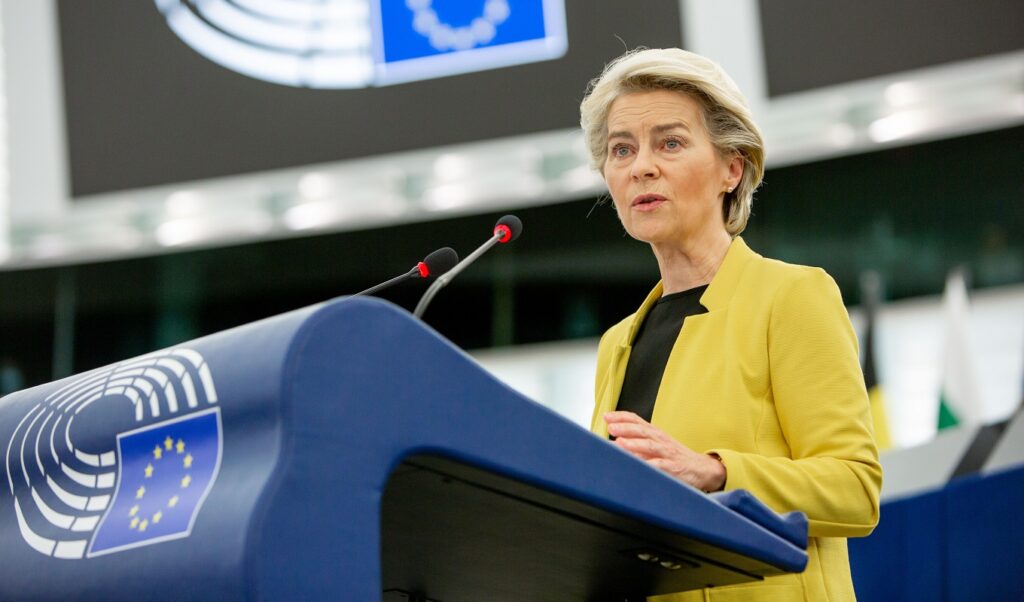Politico analyzes the “winners” and “losers” of the proposed budget from the Commission led by Ursula von der Leyen, examining the EU’s spending blueprint for the seven-year period from 2028 to 2035. The two-year negotiation road ahead promises to be “rocky,” with conflicting interests, as characteristically noted.
The European Commission President, Ursula von der Leyen, insisted that the €1.8 trillion plan would make the EU treasury “bigger,” “smarter,” and “more efficient,” claiming the budget was “the most ambitious ever proposed.”
Who wins and who loses from the EU budget, according to Politico
However, in an indication of the tough negotiations to follow, disappointed MEPs rushed to counter von der Leyen’s claims, saying the Commission had misleadingly presented adjustments for significant inflation in recent years as increases to the EU budget.
“The European Commission will present different budget items that have increased. But of course, if the budget remains at the same level, then that means several budget items will have to be reduced,” said Romanian Siegfried Muresan, a member of the center-right European People’s Party.
All member state capitals, as well as the European Parliament, must agree to the plan before its approval. As battle lines are drawn, Politico compiled a handy guide to who is favored – and who is “thrown under the bus” – in the initial proposal.
Losers: Farmers
Farmers are furious.
In the last EU long-term budget, the Common Agricultural Policy (CAP) amounted to €386.6 billion. This time, €300 billion is allocated for agriculture.
And the Commission is adding “salt to the wound.” While CAP was an autonomous budget section, it has now been merged with funding for other policies into a fund for “National and Regional Partnership Plans.”
Under these plans, European countries must spend at least €300 billion on agriculture and could spend more if they choose to do so. But farmer groups protesting outside Parliament and the Commission don’t feel optimistic.
Losers: Tobacco
While the vast majority of the budget will come from EU countries’ own contributions, the Commission also proposed three new taxes targeting electronic waste, large companies, and tobacco products like cigarettes and cigars. These goods are currently taxed by individual countries, which keep the revenues for themselves.
The target is revenue of €25 to €30 billion annually, which will be used to pay off the EU’s common debt that was used to fund post-Covid recovery.
Cigarette prices are expected to rise anyway across the EU, based on a long-awaited update to the Tobacco Tax Directive, with rough estimates suggesting the price of a pack will increase by €1-2. For the first time, alternative products like e-cigarettes and heated tobacco will be subject to a minimum rate, albeit lower than traditional cigarettes.
Losers: Nature
Biodiversity is expected to lose its own share of the EU budget, absorbed into a broader “climate and environment” target that would amount to 35% of the budget, reaching approximately €700 billion.
Previously — in addition to the 30% target for climate spending — 7.5% of annual spending was to be allocated to biodiversity targets in 2024, increasing to 10% in 2026 and 2027.
The new “climate and environment” target would serve all six of the EU’s environmental objectives, ranging from climate and biodiversity to circular economy and pollution prevention.
The LIFE program — specific funding for environment and climate action — has also been absorbed into the “National and Regional Plans” as well as the €410 billion “Competitiveness Fund” that combines many existing funding programs.
Some NGOs warn that the changes could mean biodiversity funding will lose ground. The EU already faces an estimated annual biodiversity funding gap of €37 billion, according to the European Commission.
Winners: Eastern countries and Ukraine
Eastern countries achieved a significant victory on Wednesday when the Commission announced that eastern regions, particularly those bordering Ukraine, Russia, and Belarus, will receive more funds than others to cover both security and economic needs.
They also won another battle: Despite the EU desperately seeking new money for its coffers, it did not include revenues from an already planned extension of the EU’s emissions trading system to buildings and road transport in the proposed basket of new revenue sources.
Finally, the EU proposed supporting Ukraine’s reconstruction and its path to EU membership with an additional €100 billion.
Winners: Those paying electricity bills
According to the proposal, the EU will dramatically boost support for modernizing the bloc’s electricity networks to reduce electricity prices, which were highlighted in a report by former European Central Bank chief Mario Draghi as Europe’s Achilles’ heel in competition with the US and China.
The Connecting Europe Mechanism, a fund that can be used for infrastructure upgrades and investment in new technologies, will see its energy budget increase to €30 billion from just €6 billion. Additionally, networks will tap into a generously expanded €410 billion competitiveness fund in an effort to reduce waste and cut bills for household and business energy consumption.
Winners: Digital technologies
The Commission wants to quintuple the bloc’s money for digital technologies, von der Leyen declared. This would raise digital funds to €54.8 billion in the next budget.
This is a massive increase in a sector where the EU was already investing significant capital in research and innovation. But the stakes have risen, with regions from the US to China competing fiercely for innovative technologies – primarily artificial intelligence.
Digital technology is one of four pillars of a new, integrated Competitiveness Fund with a total amount of €410 billion.
Winners: Defense
The Commission’s proposal is to allocate at least €131 billion for defense and space, which means “five times more than today,” von der Leyen said.
Separate budgets will also be used to strengthen the bloc’s defense readiness. The proposal “shows welcome ambition,” commented Hanna Neumann, a German Green MEP who sits on the European Parliament’s Defense Committee. The amount aligns with needs identified early by Defense Commissioner Andrius Kubilius when he first spoke to Politico late last year.
Winners: Research and culture
The bloc’s flagship research and development program, Horizon Europe, is set to nearly double to €175 billion. It is already one of the largest such funds in the world, with a budget of €95 billion – though an expert group argued the EU should increase its research and development spending to €220 billion to remain competitive.
The allocation for the EU’s flagship student mobility program, Erasmus+, increased by 50% to over €40 billion. The Commission also announced a new program, “AgoraEU,” worth €8.6 billion that will support culture, media, and civil society organizations.
Pending: Military mobility
The Commission wants the Union to allocate €17.7 billion for military mobility, according to Transport Commissioner Apostolos Tzitzikostas. On paper, this looks like a significant victory compared to the €1.7 billion military mobility budget in the current budget.
In reality, it falls far short of the €75 billion or even €100 billion that Tzitzikostas had stated was needed.
While parts of the transport policy budget may support dual-use infrastructure – and additional defense funds may be utilized – military needs still appear to be only partially addressed.
The Commission proposed that the future Connecting Europe mechanism, the EU’s infrastructure financing instrument, should amount to €81.4 billion. About €51 billion would be allocated for transport.
Pending: Cities and regions
The EU’s cohesion funding program aims to boost development in the bloc’s poorer regions and reduce inequality. It currently represents more than one-third of the current EU budget. But instead of being an autonomous policy in the 2028 budget proposal, cohesion funding is addressed through so-called National and Regional Partnership Plans developed by national governments.
In a last-minute deal, the Commission promises that the bloc’s poorest regions will receive €218 billion in the next budget, which was a key demand from regional commissioner Raffaele Fitto. However, no such guarantees have been given for the rest of the EU, raising fears that the total available amount for regional development will be smaller than in the current budget. This is bad news for cities and rural areas that rely on cohesion funds to finance everything from roads to public libraries.
Additionally, local and regional leaders worry about the proposed budget’s attempt to give central governments excessive power to manage and distribute EU funds through the partnership plan program and fear that national leaders could punish their political opponents by blocking access to funds.




